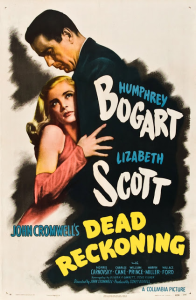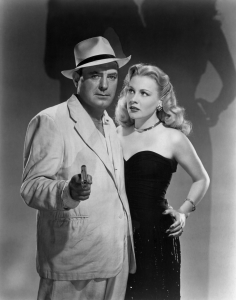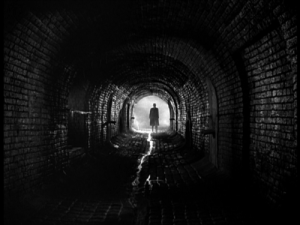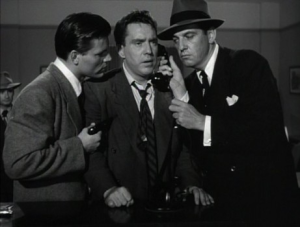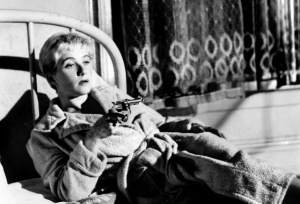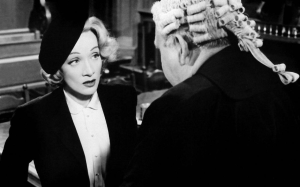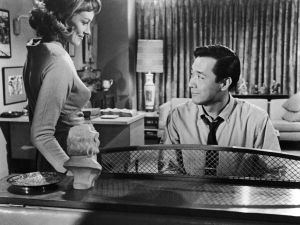If you read the last post, you know what’s going on. Here are more film suggestions for fans of noir detective stories:
DEAD RECKONING (1947)
-Put Christmas in your eyes and keep your voice low. Tell me about paradise and all the things I’m missing. I haven’t had a good laugh since before Johnny was murdered.
When Captain Warren ‘Rip’ Murdock (Humphrey Bogart) investigates the mysterious disappearance of a close friend who served with him in World War II, he finds himself caught in an intricate web of crime, romance, and double-crosses, all covered in shadows and overwrought dialogue.
I’m not gonna lie, Dead Reckoning isn’t A-list material. Even at the time, this must have felt like Frank Miller’s Sin City: derivative, contrived, artificial, and trying so hard to be hardboiled that it borders self-parody. But what can I say – I’m such a fan of the genre that if you mix the usual ingredients just right, that’s enough for me. Also, if he had been more athletic, Bogie would have made a great Batman!
RIFF-RAFF (1947)
-You shouldn’t do that, Mr. Hammer. It gives the place a bad reputation.
-You mean a worse reputation.
Not so much a mystery as a snappy adventure about charming detective Dan Hammer (Pat O’Brien) who operates out of Panama City and unwittingly comes into the possession of a map showing the locations of oil deposits in South America, which everyone seems to be after. Besides being an entertaining watch, Riff-Raff has a kick-ass opening sequence.
I LOVE TROUBLE (1948)
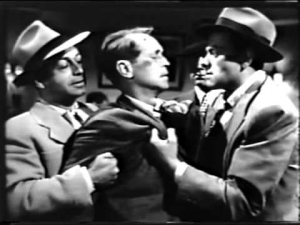 -People don’t spot me when I’m following, unless they’re looking for it. Your wife was looking for it.
-People don’t spot me when I’m following, unless they’re looking for it. Your wife was looking for it.
This B-movie has pretty much all you can ask from a mystery film noir. There is a wisecracking private eye (Franchot Tone), a circuitous plot full of twists and tension, chiaroscuro photography, intriguing femme fatales, and smart, fast-paced repartee. Pure fun.
THE THIRD MAN (1949)
-Nobody thinks in terms of human beings. Governments don’t. Why should we? They talk about the people and the proletariat, I talk about the suckers and the mugs – it’s the same thing.
American pulp writer Holly Martins (Joseph Cotton) arrives in occupied Vienna, only to find out that his childhood friend has died in suspicious circumstances. Add to this premise black market dealings, cold war politics, and an engrossing love triangle. Plus gorgeous cinematography and a superb zither-based musical score. And a bunch of memorable moments like the chase through the sewers and Orson Welles’ cuckoo clock monologue. AND one of the coolest closing shots I can think of!
Writer Graham Greene and director Carol Reed did some fine work together (the previous year, they had worked on the excellent The Fallen Idol), but this really is something special. The Third Man isn’t just the best film on this list, it’s one of the greatest movies ever.
D.O.A. (1950)
-You’re just like any other man, only more so.
Man walks into a police station. ‘I’d like to report a murder.’ A cop asks him where the murder was committed. ‘San Francisco, last night.’ The cop asks who was murdered. The man replies: ‘I was.’
The man is accountant and notary Frank Bigelow (Edmond O’Brien), an average guy who was poisoned and has just a few days to live, which he uses to find out who killed him and why. In the ensuing thriller, O’Brien runs and shouts and fights and sweats like a pig.
The movie is in public domain, so there is no excuse not to watch it.
KISS ME DEADLY (1955)
-What’s this all about? I’ll make a quick guess. You were out with some guy who thought “no” was a three-letter word.
Nominally an adaptation of a Mickey Spillane novel (with Ralph Meeker playing Mike Hammer), Kiss Me Deadly is equal parts detective story and deconstruction of the detective archetype… and that’s before the plot completely departs from the book by turning into a macabre cold war fantasy. Regardless, what an ending!
In the way that it takes the film noir format but treats it in an ironic, almost dreamlike fashion, Kiss Me Deadly anticipates such L.A.-set meandering postmodern mystery movies as The Long Goodbye, The Big Lebowski, and Inherent Vice.
WITNESS FOR THE PROSECUTION (1957)
-Touching isn’t it? The way he counts on his wife…
-Yes, like a drowning man clutching at a razor blade.
When people talk about Billy Wilder’s film noirs, they tend to bring up classic masterpieces like Double Indemnity, Sunset Boulevard, and Ace in the Hole. But although minor in comparison, Witness for the Prosecution is also a must-see, especially as far as mysteries go. Based on an Agatha Christie play, it tells the story of Sir Wilfrid Robarts (Charles Laughton), a London barrister who takes a client accused of murder (Tyrone Power) despite strong circumstantial evidence pointing to him as the killer.
The true star of picture, though, is Marlene Dietrich as Power’s wife. Her character has something of Dietrich’s complex femme fatales in early talkies like Morocco and Shanghai Express, but most of all she seems to pick up from where she left off in Wilder’s brilliant satire A Foreign Affair.
THE CRIMSON KIMONO (1959)
-Life is like a battle. Someone has to get a bloody nose.
Two police detectives and Korean War veterans, Charlie Bancroft (Glenn Corbett) and Joe Kajaku (James Shigeta), investigate the murder of a burlesque stripper in this lurid drama about race relations revolving around Los Angeles’ Asian-American community.
Leave it to Sam Fuller to take what seems like a basic whodunit and throw it into unexpected directions… To quote the essential blog Film Noir of the Week: ‘Fuller’s films exist in their own bizarre world. It’s a pulpy, slangy, slapdash place where plot threads are picked up and abandoned willy-nilly, where stuntmen’s faces are clearly visible during fight scenes, and where emotion trumps reason.’ Indeed, more than a mystery, a romantic drama, or a social problem film, The Crimson Kimono is above all a feverish mess of Fuller craziness, zigging when you think it will zag, with quirky artists and samurai lovers coming and going between odd karate set pieces. Like the story and characters, the editing is mesmerizing – sometimes ultra-stylish (check out the amazing opening!) and sometimes puzzling (who exactly is in that final chase through the parade?), but never boring.

